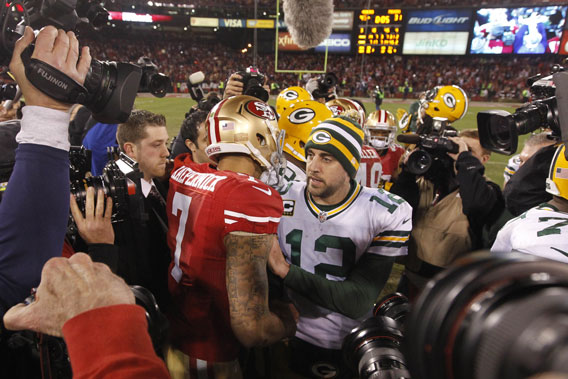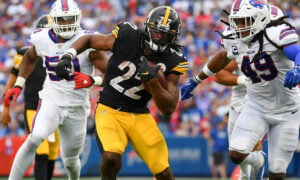2012 Quarterback Efficiency Rankings: Part One
 Fantasy points don’t exist in a vacuum. Sure, you can look at a player’s total fantasy output from any given season and determine how well he did relative to the field, but you’d be missing one very important, big-picture question – how did he get there? If we consider week one of the regular season as “Point A” and week 17 as “Point B,” we now have up to 16 individual data points that combine to determine the path each player walked. In most all cases it won’t be a straight line, but rather a series of peaks and valleys, constantly oscillating between good, bad and average fantasy performances.
Fantasy points don’t exist in a vacuum. Sure, you can look at a player’s total fantasy output from any given season and determine how well he did relative to the field, but you’d be missing one very important, big-picture question – how did he get there? If we consider week one of the regular season as “Point A” and week 17 as “Point B,” we now have up to 16 individual data points that combine to determine the path each player walked. In most all cases it won’t be a straight line, but rather a series of peaks and valleys, constantly oscillating between good, bad and average fantasy performances.
For quarterbacks, we can break this down into an additive set of statistics: total yards, touchdowns, interceptions, fumbles, etc. However, doing so still places each signal caller on his own personal pedestal and allows only for an indirect comparison to his peers. That’s because no two fantasy-relevant quarterbacks walked the exact same path between Points A and B – each submitted a season based upon a unique set of statistics. How can we normalize each set of data, thereby affording a direct means of comparison?
This is where the quarterback efficiency rankings come in.
In order to directly differentiate the top 35 fantasy quarterbacks of 2012, I took each signal caller’s total fantasy points and subtracted the points gained from rushing (rushing yards and rushing touchdowns), leaving only points gained from passing (passing yards and touchdowns). I then divided the resultant number by each player’s number of passing attempts. By doing this, every quarterback’s statistics could be broken down into the universal unit of fantasy points per passing attempt, or PPA. In short, it describes the efficiency level of each signal caller.
Before we provide the solution to that question, it’s important to acknowledge that, as mentioned earlier, no two quarterbacks are the same – this means they have different skill sets with regards to how often they pass or run and also must play within the constraints of their designed offenses. However, even with quarterbacks who derive a non-trivial amount of fantasy points from running the ball, it’s still important to see how effective they performed as passers. Rushing statistics for quarterbacks have been proven over the years as not easily replicated, so it’s imperative to know how well each player fares in the pocket.
The table below shows exactly that. How well did each signal caller fare on a per-play basis when they threw the ball? The PPA numbers in the far right column, listed in descending order, answer that very question. It also includes each player’s fantasy ranking from the 2012 season, to serve as a relative point of comparison.
|
Name |
Team* |
2012 Rank |
2012 Fantasy Points** |
Rushing Points |
Passing Points |
Pass Attempts |
PPA |
|
Aaron Rodgers |
Packers |
QB2 |
409.1 |
37.9 |
371.2 |
553 |
0.671 |
|
Russell Wilson |
Seahawks |
QB11 |
332.8 |
72.9 |
259.9 |
393 |
0.661 |
|
Peyton Manning |
Broncos |
QB6 |
382.1 |
0.7 |
381.4 |
583 |
0.654 |
|
Drew Brees |
Saints |
QB1 |
437.4 |
6.5 |
430.9 |
670 |
0.643 |
|
Alex Smith |
49ers |
QB31 |
152.1 |
13.2 |
138.9 |
218 |
0.637 |
|
Robert Griffin III |
Redskins |
QB9 |
365.9 |
125.3 |
240.6 |
394 |
0.611 |
|
Colin Kaepernick |
49ers |
QB27 |
202.2 |
71.7 |
130.5 |
218 |
0.599 |
|
Ben Roethlisberger |
Steelers |
QB21 |
276.5 |
9.2 |
267.3 |
449 |
0.595 |
|
Tom Brady |
Patriots |
QB3 |
404.6 |
27.2 |
377.4 |
638 |
0.592 |
|
Matt Ryan |
Falcons |
QB5 |
383.8 |
19.8 |
364.0 |
615 |
0.592 |
|
Eli Manning |
Giants |
QB14 |
304.4 |
3.0 |
301.4 |
536 |
0.562 |
|
Josh Freeman |
Bucs |
QB13 |
324.8 |
13.5 |
311.3 |
558 |
0.558 |
|
Cam Newton |
Panthers |
QB4 |
391.6 |
122.1 |
269.5 |
485 |
0.556 |
|
Tony Romo |
Cowboys |
QB7 |
368.1 |
10.9 |
357.2 |
648 |
0.551 |
|
Andy Dalton |
Bengals |
QB12 |
327.5 |
36.0 |
291.5 |
529 |
0.551 |
|
Philip Rivers |
Chargers |
QB18 |
288.4 |
4.0 |
284.4 |
527 |
0.540 |
|
Matt Schaub |
Texans |
QB20 |
287.5 |
0.0 |
287.5 |
544 |
0.528 |
|
Ryan Fitzpatrick |
Bills |
QB17 |
292.1 |
26.1 |
266.0 |
505 |
0.527 |
|
Joe Flacco |
Ravens |
QB15 |
299.1 |
20.2 |
278.9 |
531 |
0.525 |
|
Jay Cutler |
Bears |
QB23 |
251.0 |
23.3 |
227.7 |
434 |
0.525 |
|
Carson Palmer |
Raiders |
QB16 |
298.5 |
9.6 |
288.9 |
565 |
0.511 |
|
Andrew Luck |
Colts |
QB8 |
366.2 |
55.5 |
310.7 |
627 |
0.496 |
|
Kevin Kolb |
Cardinals |
QB35 |
106.8 |
16.3 |
90.5 |
183 |
0.495 |
|
Sam Bradford |
Rams |
QB19 |
287.9 |
18.8 |
269.1 |
552 |
0.488 |
|
Chad Henne |
Jaguars |
QB30 |
160.9 |
12.4 |
148.5 |
307 |
0.484 |
|
Jake Locker |
Titans |
QB29 |
183.9 |
35.1 |
148.8 |
314 |
0.474 |
|
Michael Vick |
Eagles |
QB26 |
206.6 |
40.5 |
166.1 |
351 |
0.473 |
|
Christian Ponder |
Vikings |
QB22 |
255.4 |
36.6 |
218.8 |
483 |
0.453 |
|
Matt Stafford |
Lions |
QB10 |
365.1 |
36.8 |
328.3 |
727 |
0.452 |
|
Ryan Tannehill |
Dolphins |
QB24 |
244.4 |
31.7 |
212.7 |
484 |
0.440 |
|
Brandon Weeden |
Browns |
QB25 |
236.4 |
11.1 |
225.3 |
517 |
0.438 |
|
Mark Sanchez |
Jets |
QB28 |
199.0 |
2.8 |
196.2 |
453 |
0.433 |
|
Blaine Gabbert |
Jaguars |
QB33 |
124.7 |
5.6 |
119.1 |
278 |
0.428 |
|
Nick Foles |
Eagles |
QB34 |
119.3 |
10.2 |
109.1 |
265 |
0.412 |
|
Matt Cassel |
Chiefs |
QB32 |
134.3 |
20.5 |
113.8 |
277 |
0.411 |
*Listed teams are from the 2012 season and not necessarily currently accurate
**Standard WCOFF scoring was used for the fantasy points (0.05 points per passing yard, 4 points per passing touchdown, 0.1 points per rushing yard, 6 points per rushing touchdown and no penalty for turnovers)
Upon looking at this data, you might find yourself wondering why PPA is such an important metric? To answer that, let’s compare the players who finished first and tenth in the efficiency rankings, Aaron Rodgers and Matt Ryan. Assuming each player attempted 550 passes in a season, how would their total points differ?
With a PPA of 0.671, Rodgers would turn those 550 passes into a total of 369.1 points. With a PPA of 0.592, Ryan’s fantasy output would stand at 325.6 points, a difference of 43.5 points, and 2.7 points per game – that’s a big drop-off considering both players are regarded as QB1 options in standard scoring formats.
Delving deeper, it’s critical to determine a correlation between each player’s PPA rank and overall fantasy rank. In other words, was their efficiency commensurate with their fantasy finish, or did additional factors conspire to cause a difference? The next table explores just that:
|
Name |
2012 Fantasy Rank |
2012 Efficiency Rank |
Change |
|
Drew Brees |
1 |
4 |
-3 |
|
Aaron Rodgers |
2 |
1 |
1 |
|
Tom Brady |
3 |
9 |
-6 |
|
Cam Newton |
4 |
13 |
-9 |
|
Matt Ryan |
5 |
10 |
-5 |
|
Peyton Manning |
6 |
3 |
3 |
|
Tony Romo |
7 |
14 |
-7 |
|
Andrew Luck |
8 |
22 |
-14 |
|
Robert Griffin III |
9 |
6 |
3 |
|
Matt Stafford |
10 |
29 |
-19 |
|
Russell Wilson |
11 |
2 |
9 |
|
Andy Dalton |
12 |
15 |
-3 |
|
Josh Freeman |
13 |
12 |
1 |
|
Eli Manning |
14 |
11 |
3 |
|
Joe Flacco |
15 |
19 |
-4 |
|
Carson Palmer |
16 |
21 |
-5 |
|
Ryan Fitzpatrick |
17 |
18 |
-1 |
|
Philip Rivers |
18 |
16 |
2 |
|
Sam Bradford |
19 |
24 |
-5 |
|
Matt Schaub |
20 |
17 |
3 |
|
Ben Roethlisberger |
21 |
8 |
13 |
|
Christian Ponder |
22 |
28 |
-6 |
|
Jay Cutler |
23 |
20 |
3 |
|
Ryan Tannehill |
24 |
30 |
-6 |
|
Brandon Weeden |
25 |
31 |
-6 |
|
Michael Vick |
26 |
27 |
-1 |
|
Colin Kaepernick |
27 |
7 |
20 |
|
Mark Sanchez |
28 |
32 |
-4 |
|
Jake Locker |
29 |
26 |
3 |
|
Chad Henne |
30 |
25 |
5 |
|
Alex Smith |
31 |
5 |
26 |
|
Matt Cassel |
32 |
25 |
7 |
|
Blaine Gabbert |
33 |
33 |
0 |
|
Nick Foles |
34 |
34 |
0 |
|
Kevin Kolb |
35 |
23 |
12 |
While the vast majority of players profiled had similar rankings between the two statistics (a difference of ±5 was seen for 20 of the 35 quarterbacks), there were also several outliers. What was the reason for these differences and which players can be expected to replicate their fantasy statistics in 2013? Check back tomorrow for Part Two to find out!
Follow me on Twitter @EDH_27
- Forgotten Dynasty Veterans: Bottom Tier - April 9, 2024
- Dynasty Fantasy Football Mailbag: How Much Should You Factor in Off-Field Issues? - April 9, 2024
- Forgotten Dynasty Veterans: Middle Tier - April 7, 2024


































































